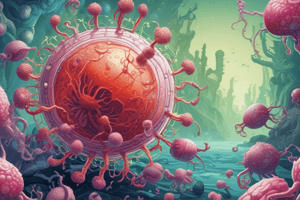Podcast
Questions and Answers
What type of bacteria live free in nature and do not cause disease?
What type of bacteria live free in nature and do not cause disease?
- Pathogenic bacteria
- Commensal bacteria
- Saprophytic bacteria (correct)
- Opportunistic bacteria
What are bacteria that can cause disease under certain conditions called?
What are bacteria that can cause disease under certain conditions called?
- Saprophytic bacteria
- Opportunistic bacteria (correct)
- Pathogenic bacteria
- Commensal bacteria
Which type of bacteria normally live on or in the human body without causing disease?
Which type of bacteria normally live on or in the human body without causing disease?
- Pathogenic bacteria
- Opportunistic bacteria
- Commensal bacteria (correct)
- Saprophytic bacteria
Which of the following describes pathogenic bacteria?
Which of the following describes pathogenic bacteria?
Which type of bacteria can be considered potential pathogens when circumstances permit?
Which type of bacteria can be considered potential pathogens when circumstances permit?
What happens when the host defense decreases or resident flora is disturbed?
What happens when the host defense decreases or resident flora is disturbed?
What describes normal microbial flora?
What describes normal microbial flora?
Which of the following scenarios can lead to urinary infections?
Which of the following scenarios can lead to urinary infections?
Which statement about microbial flora is accurate?
Which statement about microbial flora is accurate?
How can disturbance of resident flora occur?
How can disturbance of resident flora occur?
What are the two groups of normal flora?
What are the two groups of normal flora?
What is the role of pili in bacteria?
What is the role of pili in bacteria?
Which of the following is NOT a virulence factor?
Which of the following is NOT a virulence factor?
What is one example of an invasive virulence factor?
What is one example of an invasive virulence factor?
Which virulence factor helps bacteria to evade the immune response?
Which virulence factor helps bacteria to evade the immune response?
What role do antiphagocytic factors play in bacterial infection?
What role do antiphagocytic factors play in bacterial infection?
Which bacterial structures are specifically mentioned as antiphagocytic factors?
Which bacterial structures are specifically mentioned as antiphagocytic factors?
What effect does the bacterial capsule have on white blood cells?
What effect does the bacterial capsule have on white blood cells?
Which of the following bacteria is NOT listed as having an antiphagocytic capsule?
Which of the following bacteria is NOT listed as having an antiphagocytic capsule?
What is the primary consequence of bacterial invasion facilitated by antiphagocytic factors?
What is the primary consequence of bacterial invasion facilitated by antiphagocytic factors?
What is the primary function of pili in bacteria such as Neisseria gonorrhoeae and E. coli?
What is the primary function of pili in bacteria such as Neisseria gonorrhoeae and E. coli?
What characterizes a biofilm?
What characterizes a biofilm?
What happens to the risk of infection as the duration of a urinary catheter increases?
What happens to the risk of infection as the duration of a urinary catheter increases?
What is the primary function of collagenase and hyaluronidase?
What is the primary function of collagenase and hyaluronidase?
Which of the following materials can form dental plaque as a biofilm?
Which of the following materials can form dental plaque as a biofilm?
What is the main role of streptokinase?
What is the main role of streptokinase?
What is the relationship between microorganisms in biofilms and the surfaces they adhere to?
What is the relationship between microorganisms in biofilms and the surfaces they adhere to?
What are the two types of toxins mentioned?
What are the two types of toxins mentioned?
Which of the following statements about extracellular enzymes is true?
Which of the following statements about extracellular enzymes is true?
Which substance do collagenase and hyaluronidase primarily target?
Which substance do collagenase and hyaluronidase primarily target?
Flashcards
Pathogenic bacteria
Pathogenic bacteria
Bacteria that cause diseases
Saprophytic bacteria
Saprophytic bacteria
Bacteria that live freely in nature and do not cause disease.
Commensal bacteria
Commensal bacteria
Bacteria that live on or in human bodies without causing disease.
Opportunistic bacteria
Opportunistic bacteria
Signup and view all the flashcards
Normal flora
Normal flora
Signup and view all the flashcards
Resident normal flora
Resident normal flora
Signup and view all the flashcards
Transient normal flora
Transient normal flora
Signup and view all the flashcards
Virulence factors
Virulence factors
Signup and view all the flashcards
Adherence factors
Adherence factors
Signup and view all the flashcards
Pili
Pili
Signup and view all the flashcards
Normal Microbial Flora
Normal Microbial Flora
Signup and view all the flashcards
Host Defense Decrease
Host Defense Decrease
Signup and view all the flashcards
Resident Flora Disturbance
Resident Flora Disturbance
Signup and view all the flashcards
Example of Flora Shift
Example of Flora Shift
Signup and view all the flashcards
S.epidermidis
S.epidermidis
Signup and view all the flashcards
Biofilm
Biofilm
Signup and view all the flashcards
Urinary Catheters and Biofilms
Urinary Catheters and Biofilms
Signup and view all the flashcards
Dental Plaque
Dental Plaque
Signup and view all the flashcards
Biofilms and Infections
Biofilms and Infections
Signup and view all the flashcards
Antiphagocytic Factors
Antiphagocytic Factors
Signup and view all the flashcards
Capsule
Capsule
Signup and view all the flashcards
S. pneumoniae, N. meningitidis, H. influenzae
S. pneumoniae, N. meningitidis, H. influenzae
Signup and view all the flashcards
What do antiphagocytic factors do?
What do antiphagocytic factors do?
Signup and view all the flashcards
Why is a capsule important for bacteria?
Why is a capsule important for bacteria?
Signup and view all the flashcards
Collagenase and Hyaluronidase
Collagenase and Hyaluronidase
Signup and view all the flashcards
Streptokinase
Streptokinase
Signup and view all the flashcards
Exotoxins
Exotoxins
Signup and view all the flashcards
Endotoxins
Endotoxins
Signup and view all the flashcards
What's the key difference between exotoxins and endotoxins?
What's the key difference between exotoxins and endotoxins?
Signup and view all the flashcards
Study Notes
Virulence Factors
- Virulence factors are structures or products that help bacteria cause disease.
- Bacteria are categorized into saprophytic, parasitic, and pathogenic based on their roles.
- Saprophytic bacteria live freely in nature and do not cause disease.
- Pathogenic bacteria cause disease.
- Normal flora (commensal bacteria) live on or in the human body and typically do not cause disease.
- Opportunistic bacteria are commensal bacteria that can cause disease under certain conditions. They become pathogens if host defenses decrease or resident flora is disturbed, causing them to move to other sites.
Normal Microbial Flora
- Normal microbial flora are microorganisms that inhabit the skin and mucous membranes of a healthy person.
- Two groups:
- Resident normal flora resides permanently.
- Transient normal flora is temporary.
Virulence Factors
- Categories of virulence factors include adherence factors, invasive factors, and toxin production.
Adherence Factors
- These are structures, like pili, that help bacteria attach to host cell mucous membranes.
- Pili (hair-like appendages) on bacteria like Neisseria gonorrhoeae and E. coli help them attach to the urinary tract epithelium.
Biofilms
- Biofilms are millions of microorganisms sticking to each other and surfaces (e.g., foreign materials like urinary catheters).
- Longer urinary catheters lead to increased biofilm formation and infection.
- Dental plaque is an example of a biofilm on teeth.
Invasive Factors
- These help bacteria invade tissue, multiply, and spread rapidly, causing inflammation.
- Antiphagocytic factors prevent phagocytosis (engulfment by white blood cells)
- Capsule prevents phagocytosis, and is found in S. pneumoniae, N. meningitidis, and H. influenzae.
- Extracellular enzymes degrade tissues to allow bacterial spread.
- Collagenase and hyaluronidase degrade collagen and hyaluronic acid, enabling bacterial dispersal through subcutaneous tissues.
- Streptokinase (fibrinolysin) breaks down blood clots.
- Antiphagocytic factors prevent phagocytosis (engulfment by white blood cells)
Toxins
- Two types of toxins: exotoxins and endotoxins.
- Exotoxins are proteins secreted by bacteria. They are highly specific in action.
- Gram-positive and gram-negative bacteria produce exotoxins.
- Endotoxins are lipopolysaccharides released when bacteria die. They are less specific.
- Endotoxins are produced only by Gram-negative bacteria.
- Exotoxins are proteins secreted by bacteria. They are highly specific in action.
Studying That Suits You
Use AI to generate personalized quizzes and flashcards to suit your learning preferences.
Related Documents
Description
This quiz tests your knowledge on the virulence factors of bacteria and the role of normal microbial flora. Learn about the differences between saprophytic, pathogenic, and opportunistic bacteria, as well as the types of normal flora. Understand how these factors contribute to disease and health.




